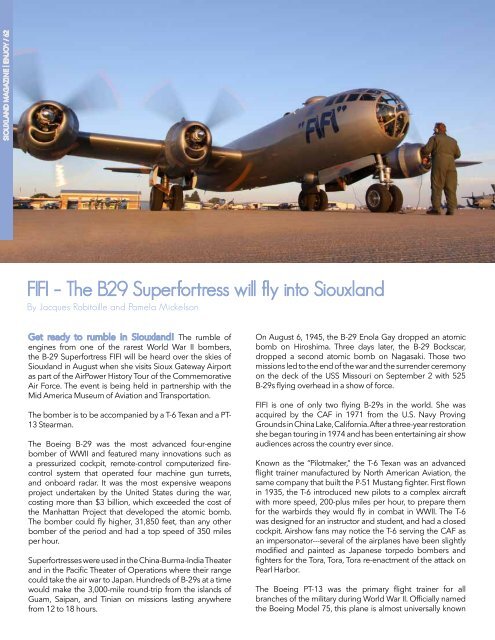Siouxland Magazine - Volume 1 Issue 4
Create successful ePaper yourself
Turn your PDF publications into a flip-book with our unique Google optimized e-Paper software.
<strong>Siouxland</strong> <strong>Magazine</strong> | Enjoy / 62<br />
FIFI – The B29 Superfortress will fly into <strong>Siouxland</strong><br />
By Jacques Robitaille and Pamela Mickelson<br />
Get ready to rumble in <strong>Siouxland</strong>! The rumble of<br />
engines from one of the rarest World War II bombers,<br />
the B-29 Superfortress FIFI will be heard over the skies of<br />
<strong>Siouxland</strong> in August when she visits Sioux Gateway Airport<br />
as part of the AirPower History Tour of the Commemorative<br />
Air Force. The event is being held in partnership with the<br />
Mid America Museum of Aviation and Transportation.<br />
The bomber is to be accompanied by a T-6 Texan and a PT-<br />
13 Stearman.<br />
The Boeing B-29 was the most advanced four-engine<br />
bomber of WWII and featured many innovations such as<br />
a pressurized cockpit, remote-control computerized firecontrol<br />
system that operated four machine gun turrets,<br />
and onboard radar. It was the most expensive weapons<br />
project undertaken by the United States during the war,<br />
costing more than $3 billion, which exceeded the cost of<br />
the Manhattan Project that developed the atomic bomb.<br />
The bomber could fly higher, 31,850 feet, than any other<br />
bomber of the period and had a top speed of 350 miles<br />
per hour.<br />
Superfortresses were used in the China-Burma-India Theater<br />
and in the Pacific Theater of Operations where their range<br />
could take the air war to Japan. Hundreds of B-29s at a time<br />
would make the 3,000-mile round-trip from the islands of<br />
Guam, Saipan, and Tinian on missions lasting anywhere<br />
from 12 to 18 hours.<br />
On August 6, 1945, the B-29 Enola Gay dropped an atomic<br />
bomb on Hiroshima. Three days later, the B-29 Bockscar,<br />
dropped a second atomic bomb on Nagasaki. Those two<br />
missions led to the end of the war and the surrender ceremony<br />
on the deck of the USS Missouri on September 2 with 525<br />
B-29s flying overhead in a show of force.<br />
FIFI is one of only two flying B-29s in the world. She was<br />
acquired by the CAF in 1971 from the U.S. Navy Proving<br />
Grounds in China Lake, California. After a three-year restoration<br />
she began touring in 1974 and has been entertaining air show<br />
audiences across the country ever since.<br />
Known as the “Pilotmaker,” the T-6 Texan was an advanced<br />
flight trainer manufactured by North American Aviation, the<br />
same company that built the P-51 Mustang fighter. First flown<br />
in 1935, the T-6 introduced new pilots to a complex aircraft<br />
with more speed, 200-plus miles per hour, to prepare them<br />
for the warbirds they would fly in combat in WWII. The T-6<br />
was designed for an instructor and student, and had a closed<br />
cockpit. Airshow fans may notice the T-6 serving the CAF as<br />
an impersonator---several of the airplanes have been slightly<br />
modified and painted as Japanese torpedo bombers and<br />
fighters for the Tora, Tora, Tora re-enactment of the attack on<br />
Pearl Harbor.<br />
The Boeing PT-13 was the primary flight trainer for all<br />
branches of the military during World War II. Officially named<br />
the Boeing Model 75, this plane is almost universally known


















